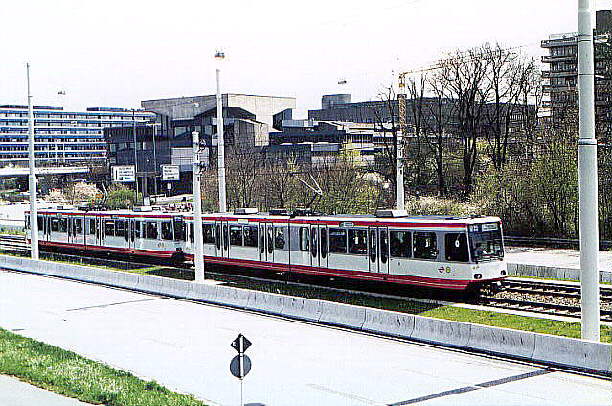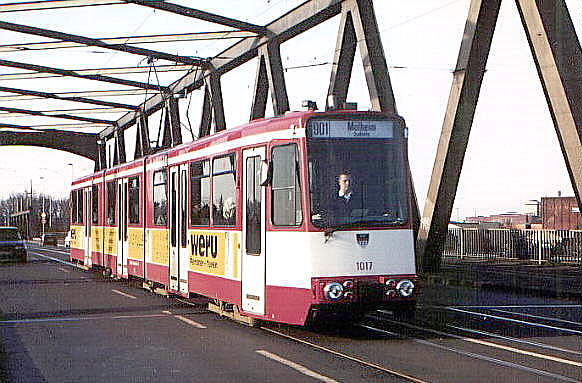
Bochum and Gelsenkirchen:
Bochum-Gelsenkirchen Bogestra (short for Bochum-Gelsenkirchener
Strassenbahnen) operates light rail and buses in the towns of Bochum,
Gelsenkirchen, Herne, Hattingen and Witten. Tram operations started in
1894, when Siemens & Halske (today the well known Siemens electrical
company) built the first line between the towns of Herne and Bochum.
At first the German Railway was opposed to new rail or tramway lines
in the Ruhr but then agreed to the tramways being built provided a
narrow gauge of 1000 mm (1 metre) was used.
The network grew quite fast, and later Siemens gave the operation to
Bogestra. Bogestra itself took over three smaller tramway companies.
By 1939 the network was the fifth-biggest in Germany, 195 km long.
After the war some lines closed, leaving the current 91.6 km metre
gauge network and one 9 km standard gauge Stadtbahn line. There are
three different types of cars: old Duewag articulated 6-axle-cars from
the 1960s, modern M6S and M6C-cars from the late 1970s and early
1980s, and the new low-floor-cars MGT6D. These 1993 and 1994
low-floor-cars are similar to the Kassel-type cars, but are
double-ended. The six metre gauge lines are on the surface except for
tunnels in the centre of Bochum and Gelsenkirchen.

Metre-gauge tramways were regarded as inferior so in the 1960s it was
decided to rebuilt all such lines to standard-gauge Stadtbahn
standards. Bogestra's first Stadtbahn-line was built between Bochum
and Herne, replacing the original 1894 tramway. It opened in 1989
running completely underground between the two cities with an
extension to Bochum University added in 1993. This Stadtbahn-line uses
B80D cars with high platforms. Due to high costs and small benefits
from converting to standard gauge Stadtbahn the conversion program has
been stopped. All other lines will remain narrow-gauge and the older
articulated cars and M-cars will be replaced by new low-floor light
rail vehicles as they become life-expired.
Duisburg:

The tramways of Duisburg, westernmost town in the Ruhr along
the river Rhein, have an interesting history: The predecessors of the
electric light rails were horse trams in 1881 and steam trams in 1882.
These standard gauge lines were electrified from 1897. An interurban
from Duesseldorf (also standard gauge) reached Duisburg in 1899. North
of Duisburg a 750 mm gauge horse trams was opened in 1892 followed by
a network of metre-gauge tramways from 1897. At that time the area was
not part of Duisburg, so the two systems were neither connected nor
the same gauge.
In the 1950s, all metre-gauge lines were either closed or regauged to
standard gauge, reducing length from 56.6 km to 21.6 km. Today, there
are only two long light rail-lines and one Stadtbahn-line making a
61.1 km standard gauge network. The light rail-lines are 901 and 903,
both lines use GT8NC-DU cars built between 1988 and 1993.
These cars are similar to
the B80 cars, but they are only 2.20m wide and cannot serve high
platforms. Starting in 1996, all of the GT8NC-DU cars will be extended
with a low-floor- section, renamed GT10NC-DU, 33 m long. One
100%-low-floor-car, the Variobahn from ADtranz, is being tested in
1997.
The Stadtbahn-line is U79, the former interurban operated jointly with
Duesseldorf using B80C cars, usually coupled in pairs. Some cars have
a "Speisewagen" (dining car) section, but only drinks are sold.
Although many German systems have party cars for hire this is one of
only two light rail lines where you can buy a beer on a regular trip.
Duisburg has an underground section opened in 1992 with deep, widely
spaced stations. At the Hauptbahnhof the walk from the trains to the
light rail takes several minutes and interurban route U79 makes a time
consuming detour through the subway. Consequently this expensive
improvement is both inconvenient and increases rather than decreases
total travel times. The underground stations have long platforms with
high sections for route U79 and low sections for routes 901 and 903.
Duesseldorf:
Duesseldorf is the capital of the state of
Nordrhein-Westfalen with a dense 147.6 km light rail, standard-gauge,
network. Six and eight axle articulated single-ended cars from the
1950s and 1960s are still in service, many of them coupled with four
axle trailers. From 1996 these are slowly being replaced by low-floor
light rail vehicles. Double-ended-cars are the GT8SU from the 1970s
and the B80D from the 1980s. Both are able to run underground and can
stop either on high or low platforms. Two interurbans run in
Duesseldorf, the U79 to Duisburg (see above) and the U76 to Krefeld.
Some U76 services have a dining car. Duesseldorf has a single four
track underground line with good connections at the Hauptbahnhof.
Krefeld:
Krefeld is a small, all-surface, 37.3 km metre-gauge system
with eight-axle articulated cars and M8Cs. Four lines are operated
plus the standard-gauge U76 interurban from Duesseldorf. Krefeld is a
fast system due to traffic-light priority pioneered here in 1982,
later adopted in many places. The operator of the trams in Krefeld are the Staedtische Werke Krefeld AG.